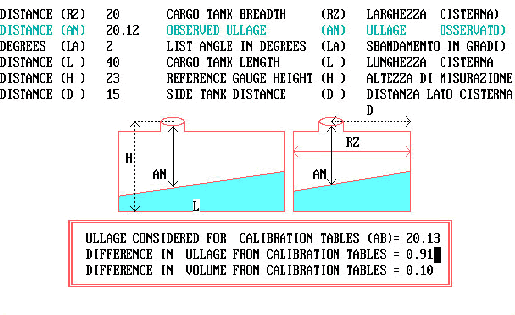|

The following DATA INPUT are requested by the program:
| ESEMPIO RZ = Breadth of the cargo tank |
20.00 m. |
| AN = Observed Ullage |
20.12 m. |
| LA = List angle in degrees |
2 degr |
| L = Length of the cargo tank |
40.00 m. |
| H = Cargo tank height from measurement point |
23.00 m. |
| D = Distance measur.point to listed bulkhead |
15.00 m. |
Soon after will appear to the monitor the following result:
ULLAGE = 20.13 m.
From calibration table we can see that ULLAGE 20.13 m. is between
gli ULLAGES 20.10 and 20.20 (metres),corresponding to the volumes
2835 and 2743 (Cubic metres). Computer will ask you the difference
of said ullages (20.20 - 20.10 = 0.10 metres) and also the difference
of the two volumes (2835 - 2743 = 92 cub.m.) as follows:
| Ullage difference |
0.10 metres |
| Volume difference |
92 |
with the following result:
ULLAGE = 19.91 m.
You have to repeat the above procedure:
ULLAGE 19.91 metres is between ullages 19.90 and 20.00 with the
following volumes 3017 and 2926; Computer will ask you the difference(20.00
- 19.90 = 0.10) and (3017 - 2926 = 91) as follows:
| Ullage difference |
0.10 metres |
| Volume difference |
91 cub.m |
The final calculation resulted to be :ULLAGE = 19.91 m.
When the last two results have the same values, the program will
stop automatically and the observed ullage of 20.12 metres with
the vessel aft. trimmed and listed, become 19.91 metres with the
vessel Even Keel and ZERO listed. From calibration tables you
can find the corrected volume at corresponding ullage of 19.91
metres.
|
